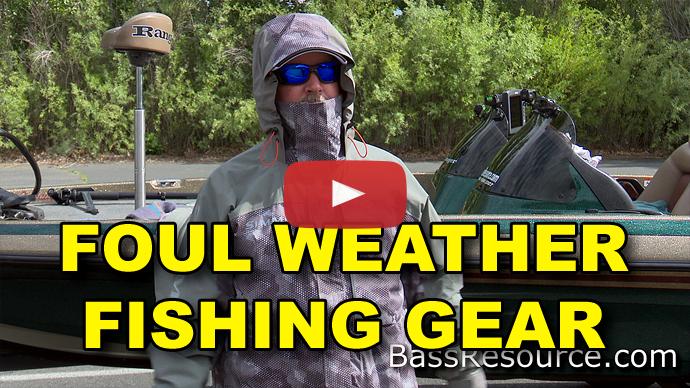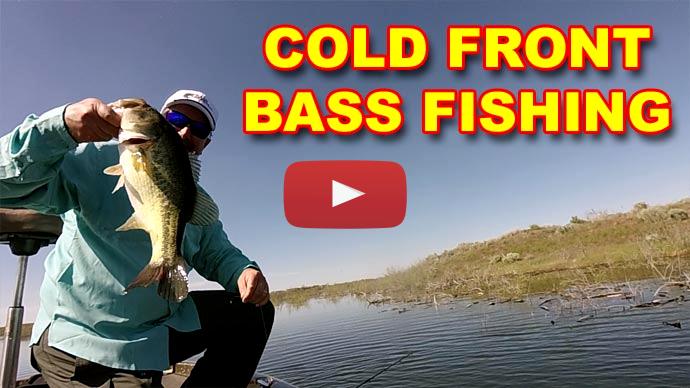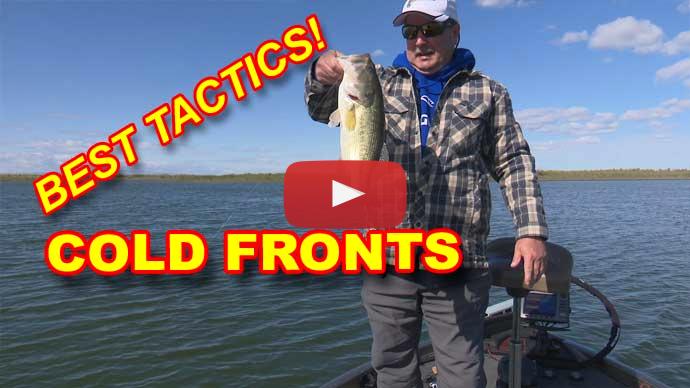All right, so it's been raining, it's finally stopped, and you want to go fishing. And how is that going to affect the way you fish, where you fish, how you fish? So, that's what we're talking about here.
First thing, you need to understand is when it rains, was that associated with a cold front? Like, pay attention to the weather because if that cold front came through and it rained as part of that cold front, the cold front takes precedence. What you're fishing now, is especially, if it's the next day or two after that rain went through, is post-front conditions. And that can be tough. That means the bite has really shut down. It's slow fishing. The fish are just not really willing to come out and play.
So, to approach that, you need to go to your finesse tactics, your smaller baits, your drop shot, your split shot, your finesse jigs, tube baits, you know, those things, and fish them very slowly and in deeper water. Deeper water, fish are less affected by cold fronts than the fish that were in shallow water. So, that is very important when you look at when it rained, was it part of a cold front, because that dictates everything.
If it wasn't associated with a cold front or if you're fishing, say, three days or more past the cold front, because the first two days after a cold front go through, that's the conditions I was just telling you about. But once you get on that third day and conditions are stable, things start to improve.
And if it's rained since then, a couple of things can happen. If the rain wasn't all that much, let's say, you've had a dry spell for a while, and then you had some light rain that come through. That, actually, can be a real big boon because the tributaries and the creeks, they have filled up with insects and when the rain comes through and washes that into the river or into the lake... Man, the bait fish come up and they start feeding on that. And where the bait fish are, that's where the bass will follow. Think about culverts too. Culverts will do the same things. You know, spiders, and beetles, and whatnot set up camp in those culverts. And then, you get a light rain enough to wash them into the lake. That could be a lot of fun. Just go from creek to creek and culvert to culvert and you can have yourself a heck of a day.
However, if it rains really hard, if for example, you had a real strong heavy downpour or maybe a week of strong heavy rains, that changes things. A number of factors can happen which can affect the way you fish.
First, of all, is muddy water. Muddy water can change everything. And the thing you need to think about first of all is getting those creeks, tributaries, culverts, that's where the muddy water is going to come from. So, if it's recently been after a rain, what you'll have is back in those areas where that water enters, it's going to be all muddied up until it meets the clear water of the lake. And what you'll get is a mud line.
The mud line... The fish will treat that just like a weed line and the bass will be inside the mud line and they'll dart out into clear water, attacking prey that happens to go by. So, fish it just like you would a weed line. The way you do that are things, like, crankbaits, spinnerbaits, plastics, just on the edge of that mud line just like you would a weed line, and you can, actually, catch a lot of fish that way.
However, if it's been a while since that downpour or like I said, you've had a week of heavy downpour, then the majority of that body of water is going to be muddied up. In that instance, the opposite happens. Where those creeks and tributaries and culverts are, actually, clearer water is now coming in because the rain has stopped. And, actually, if you go back to where they enter the water, that actually, could be clearer water. So, go back in those areas and fish those and you can, you know, seeking clearer water and you'll have a better day.
Think about it like also the river. If the river flows this way, a lot of muddy water comes in. A lot of muddy water. If you've got tributaries and coves that kind of go back up against the grain, against the current, they act kind of, like, eddy areas, and they may not be as muddy. So, seek out those areas that aren't as muddy and you can have, you know, a better day of fishing.
That said, sometimes you've got a natural lake, and it just has one inlet and one outlet, and the whole thing's muddied up when you show up at the ramp. That's not, necessarily, a bad thing because sometimes those fish, they're used to stained or somewhat clear water, and now it gets all muddy and they're actively feeding. They may, actually, turn them on. They may roam more, they may be more active. And so, faster-moving baits, loud moving baits, such as: rattling crankbaits, flashing crankbaits, flashy color crankbaits like chartreuse, fire tiger, or even chrome, spinnerbaits, larger sized spinnerbaits that put out a good thump of Colorado or Indiana blades, those types of things can be really good.
My partner and I one time, we fished a lake. One weekend it was fine and then it started to pour on that Sunday, and it rained heavily through Wednesday. I mean big time. And when we showed up on that Saturday, it was just chocolate milk colored. And we're like, "Oh gosh, this is going to be a tough day of fishing." Actually, the opposite was true. We caught 60 to 70 bass per day and all of them were on big thumping spinnerbaits and rattling crankbaits, larger size. So, we were 1/2-ounce to 3/4-ounce Rat-L-Traps, 3/4-ounce spinnerbaits. And we almost called the shot. It was like every other cast it seemed like, we were just catching a bunch of fish. It was so much fun.
So, that can be a good thing. But you have to think about other factors involved as well. So, if the water is rising because of this heavy rain, typically, what happens when the water rises, bass move into the shallows as soon as they can fit into it. I mean, they go right into it because that's where the insects, and vertebrae, and the baitfish will go in there. And you got to fish super shallow and it can be a lot of fun. The fish can be really...even if it's muddy, you can have a lot...you have a lot of fun fishing that shallow water.
However, pay attention if you're in a river system or you're in a reservoir where they may say, "Hey, look, we've got way too much water, it's flooding.” They may open up the floodgates. And they're trying to lower the lake level.
And if that's the case, if the water level is, actually, dropping by the time you get to it, the bass will vacate dropping water faster than a heartbeat. Their instincts kick in, they don't want to be trapped, and so they'll go to deeper water right away. So, pay close attention when you show up just because your water level is really high, it doesn't, necessarily, mean they're going to be shallow. They probably are, but see if they're emptying out the floodgates, if the water is lowering, then you may have to go deeper and find them that way.
Another thing that's important to note is if you've had a heavy rain, especially, if it's rained for quite a while, this may create current in your body of water. Even if it's a natural lake where you have a normal inflow and outflow, if the water level has risen a bit, water is gonna drain, like, water drains, and it's going to create current. Now, it could be strong or it could be really a light current or if you're in a reservoir system or a river system, they may open up those floodgates and you get stronger current than normal. So, pay close attention to that because that's gonna position the bass and their feeding characteristics.
Typically, they get more aggressive when they feed, but they're going to be positioned on points, on humps, secondary points, little eddy areas, places that serve as a current break where they can hide behind, and they can ambush prey as it comes by as a current flows through. So, pay close attention to that because your normal areas that you would fish may change based upon a stronger current.
It's, also, important to note the water temperature. Because, say for example, in early spring, water temperature is kind of cool and you have a warm rain that comes through. The water temperatures go up, the air temperature goes up, the rain is warmer than the lake. When you get a heavy downpour like that, it's gonna warm up the shallows faster, and the fish will actually get more active that way. It'll turn them on.
Whereas in the fall, the water is actually warm. But the temperature may have dropped. Maybe the water temperature is in the 60s or still low 70s, cold front comes through. It's colder air, say 50-degree air, 55-degree, heavy downpour. You got colder water that came in. That's gonna do the opposite. It's gonna shut down the fishing. And when that happens, it's tough fishing. And even in the fall, you could have...it could trigger a turnover.
Now, not all lakes turnover, but what could happen is during the summer, you have the warmer temperature waters at the top and the colder temperature waters at the bottom, and you get this heavy downpour of cold water, cold rain that comes down. Well, it wants to get down below where the cold water is. And what happens is that all that water that's stratified, flips and it mixes. And that's called turnover.
You can tell when you have turnover when you show up at the lake and you've got these clumps of detritus, you know, bottom, lake bottom, it's all floating around because it stirs up the bottom of the lake and some of that floats up towards the top. It even smells kind of that rotten egg kind of smell because what it is, it's organic material that's fallen to the bottom of the lake and is deteriorating, decomposing. And now, that it's risen to the surface, it stinks. What also happens is that it stirs up the color of the lake, and now the water temperature is the same from top to bottom. And it can create some real, real tough fishing conditions. Again, not all lakes turn over. So, if you encounter this in the fall, maybe pick up sticks and move to another lake nearby, it may not have that happen and you may be better off. So, just think about that when...if you... The water temperature related to the air temperature when you get that heavy rain that may influence where you fish, and the activity level of the bass.
So, those are a few things to think of when you have a heavy downpour. I hope that helps. For more tips and tricks like this, visit Bassresource.com.



